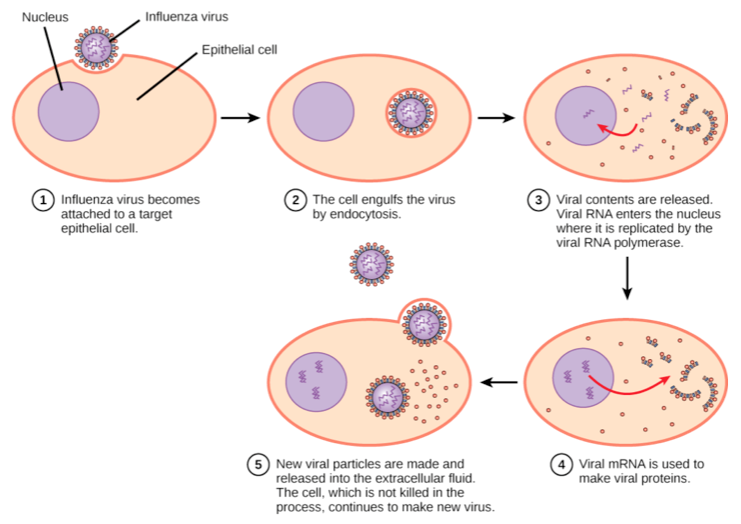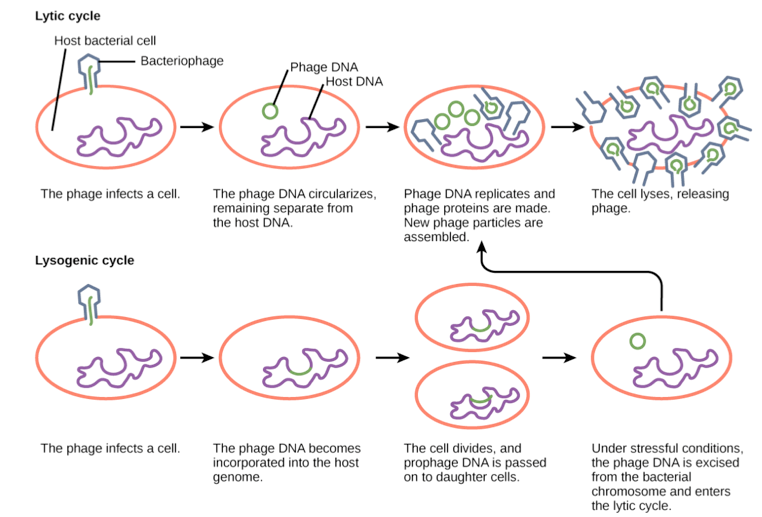Reading: Virus
Key terms
Bacteriophage: A virus that specifically infects bacteria
Glycoprotein: A protein with covalently-bonded carbohydrates
Horizontal transmission: The transmission of an infectious agent, such as bacterial, fungal, or viral infection, between members of the same species that are not in a parent-child relationship
Lysogenic cycle: A form of viral reproduction involving the fusion of the nucleic acid of a bacteriophage with that of a host, followed by proliferation of the resulting prophage
Lytic cycle: The normal process of viral reproduction involving penetration of the cell membrane, nucleic acid synthesis, and lysis of the host cell
Receptor-mediated endocytosis: A process by which cells internalize molecules (endocytosis) by the inward budding of plasma membrane vesicles containing proteins with receptor sites specific to the molecules being internalized
Retrovirus: A virus that has a genome consisting of RNA
Vertical transmission: The transmission of an infection or other disease from the female of the species to the offspring
Virion: A single individual particle of a virus (the viral equivalent of a cell)
Virus Infections and Hosts
Steps of Virus Infections
-Viral replication involves six steps: attachment, penetration, uncoating, replication, assembly, and release.
-During attachment and penetration, the virus attaches itself to a host cell and injects its genetic material into it.
-During uncoating, replication, and assembly, the viral DNA or RNA incorporates itself into the host cell's genetic material and induces it to replicate the viral genome.
-During release, the newly-created viruses are released from the host cell, either by causing the cell to break apart, waiting for the cell to die, or by budding off through the cell membrane.

Pathway to viral infection
In influenza virus infection, glycoproteins attach to a host epithelial cell. As a result, the virus is engulfed. RNA and proteins are made and assembled into new virions.
The Lytic and Lysogenic Cycles of Bacteriophages
-Viruses are species specific, but almost every species on Earth can be affected by some form of virus.
-The lytic cycle involves the reproduction of viruses using a host cell to manufacture more viruses; the viruses then burst out of the cell.
-The lysogenic cycle involves the incorporation of the viral genome into the host cell genome, infecting it from within.
Lytic versus lysogenic cycle
A temperate bacteriophage has both lytic and lysogenic cycles. In the lytic cycle, the phage replicates and lyses the host cell. In the lysogenic cycle, phage DNA is incorporated into the host genome, where it is passed on to subsequent generations. Environmental stressors such as starvation or exposure to toxic chemicals may cause the prophage to excise and enter the lytic cycle.

Animal Viruses
-Animal viruses may enter a host cell by either receptor-mediated endocytosis or by changing shape and entering the cell through the cell membrane.
-Viruses cause diseases in humans and other animals; they often have to run their course before symptoms disappear.
-Examples of viral animal diseases include hepatitis C, chicken pox, and shingles.
Chicken pox virus
Varicella-zoster, the virus that causes chickenpox, has an enveloped icosahedral capsid visible in this transmission electron micrograph. Its double-stranded DNA genome incorporates into the host DNA and reactivates after latency in the form of shingles, often exhibiting a rash.
Plant Viruses
-Plants have cell walls which protect them from viruses entering their cells, so some type of damage must occur in order for them to become infected.
-When viruses are passed between plants, it is called horizontal transmission; when they are passed from the parent plant to the offspring, it is called vertical transmission.
-Symptoms of plant virus infection include malformed leaves, black streaks on the stems, discoloration of the leaves and fruits, and ring spots.
-Plant viruses can cause major disruptions to crop growth, which in turn can have a major impact on the economy.
